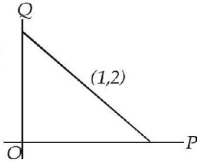Question
A line is drawn through the point (1, 2) to meet the coordinate axes at $$P$$ and $$Q$$ such that it forms a triangle $$OPQ$$, where $$O$$ is the origin. If the area of the triangle $$OPQ$$ is least, then the slope of the line $$PQ$$ is :
A.
$$ - \frac{1}{4}$$
B.
$$ - 4$$
C.
$$ - 2$$
D.
$$ - \frac{1}{2}$$
Answer :
$$ - 2$$
Solution :
Equation of a line passing through $$\left( {{x_1},{y_1}} \right)$$ having slope $$m$$ is given by $$y - {y_1} = m\left( {x - {x_1}} \right)$$
Since the line $$PQ$$ is passing through (1, 2) therefore its equation is $$\left( {y - 2} \right) = m\left( {x - 1} \right)$$
where $$m$$ is the slope of the line $$PQ.$$
Now, point $$P\left( {x,0} \right)$$ will also satisfy the equation of $$PQ.$$
$$\eqalign{ & \therefore y - 2 = m\left( {x - 1} \right) \cr & \Rightarrow 0 - 2 = m\left( {x - 1} \right) \cr & \Rightarrow \, - 2 = m\left( {x - 1} \right)\,\, \Rightarrow x - 1 = \frac{{ - 2}}{m} \cr & \Rightarrow x = \frac{{ - 2}}{m} + 1 \cr & {\text{Also, }}OP = \sqrt {{{\left( {x - 0} \right)}^2} + {{\left( {0 - 0} \right)}^2}} = x = \frac{{ - 2}}{m} + 1 \cr & {\text{Similarly, point }}Q\left( {0,y} \right){\text{ will satisfy equation of }}PQ \cr & \therefore y - 2 = m\left( {x - 1} \right) \cr & \Rightarrow y - 2 = m\left( { - 1} \right) \Rightarrow y = 2 - m{\text{ and }}OQ = y = 2 - m \cr & {\text{Area of }}\Delta POQ = \frac{1}{2}\left( {OP} \right)\left( {OQ} \right) = \frac{1}{2}\left( {1 - \frac{2}{m}} \right)\left( {2 - m} \right) \cr & \left( {\because {\text{ Area of }}\Delta = \frac{1}{2} \times {\text{base}} \times {\text{height}}} \right) \cr & = \frac{1}{2}\left[ {2 - m - \frac{4}{m} + 2} \right] = \frac{1}{2}\left[ {4 - \left( {m + \frac{4}{m}} \right)} \right] \cr & = 2 - \frac{m}{2} - \frac{2}{m} \cr} $$

$$\eqalign{ & {\text{Let}}\,{\text{Area}}\, = f\left( m \right) = 2 - \frac{m}{2} - \frac{2}{m} \cr & {\text{Now,}}\,f'\left( m \right) = \frac{{ - 1}}{2} + \frac{2}{{{m^2}}} \cr & {\text{Put}}\,f'(m) = 0\, \Rightarrow {m^2} = 4 \Rightarrow m = \pm 2 \cr & {\text{Now,}}\,f''\left( m \right) = \frac{{ - 4}}{{{m^3}}} \cr & {\left. {f''\left( m \right)} \right|_{m = 2}} = - \frac{1}{2} < 0 \cr & {\left. {f''\left( m \right)} \right|_{m = - 2}} = \frac{1}{2} > 0 \cr} $$
Area will be least at $$m = - 2$$
Hence, slope of $$PQ$$ is $$ - 2$$
Equation of a line passing through $$\left( {{x_1},{y_1}} \right)$$ having slope $$m$$ is given by $$y - {y_1} = m\left( {x - {x_1}} \right)$$
Since the line $$PQ$$ is passing through (1, 2) therefore its equation is $$\left( {y - 2} \right) = m\left( {x - 1} \right)$$
where $$m$$ is the slope of the line $$PQ.$$
Now, point $$P\left( {x,0} \right)$$ will also satisfy the equation of $$PQ.$$
$$\eqalign{ & \therefore y - 2 = m\left( {x - 1} \right) \cr & \Rightarrow 0 - 2 = m\left( {x - 1} \right) \cr & \Rightarrow \, - 2 = m\left( {x - 1} \right)\,\, \Rightarrow x - 1 = \frac{{ - 2}}{m} \cr & \Rightarrow x = \frac{{ - 2}}{m} + 1 \cr & {\text{Also, }}OP = \sqrt {{{\left( {x - 0} \right)}^2} + {{\left( {0 - 0} \right)}^2}} = x = \frac{{ - 2}}{m} + 1 \cr & {\text{Similarly, point }}Q\left( {0,y} \right){\text{ will satisfy equation of }}PQ \cr & \therefore y - 2 = m\left( {x - 1} \right) \cr & \Rightarrow y - 2 = m\left( { - 1} \right) \Rightarrow y = 2 - m{\text{ and }}OQ = y = 2 - m \cr & {\text{Area of }}\Delta POQ = \frac{1}{2}\left( {OP} \right)\left( {OQ} \right) = \frac{1}{2}\left( {1 - \frac{2}{m}} \right)\left( {2 - m} \right) \cr & \left( {\because {\text{ Area of }}\Delta = \frac{1}{2} \times {\text{base}} \times {\text{height}}} \right) \cr & = \frac{1}{2}\left[ {2 - m - \frac{4}{m} + 2} \right] = \frac{1}{2}\left[ {4 - \left( {m + \frac{4}{m}} \right)} \right] \cr & = 2 - \frac{m}{2} - \frac{2}{m} \cr} $$

$$\eqalign{ & {\text{Let}}\,{\text{Area}}\, = f\left( m \right) = 2 - \frac{m}{2} - \frac{2}{m} \cr & {\text{Now,}}\,f'\left( m \right) = \frac{{ - 1}}{2} + \frac{2}{{{m^2}}} \cr & {\text{Put}}\,f'(m) = 0\, \Rightarrow {m^2} = 4 \Rightarrow m = \pm 2 \cr & {\text{Now,}}\,f''\left( m \right) = \frac{{ - 4}}{{{m^3}}} \cr & {\left. {f''\left( m \right)} \right|_{m = 2}} = - \frac{1}{2} < 0 \cr & {\left. {f''\left( m \right)} \right|_{m = - 2}} = \frac{1}{2} > 0 \cr} $$
Area will be least at $$m = - 2$$
Hence, slope of $$PQ$$ is $$ - 2$$